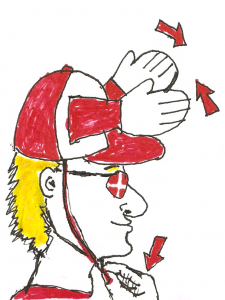What’s in a flag? Posted by Bjørn A. Bojesen on Jan 30, 2014 in Traditions
There are a couple of facts in this old legend about the origin of Dannebrog [DANNEbroh], the Danish flag. King Valdemar did in fact (brutally) conquer Estonia in 1219, and the Danish flag is as old as a flag can be (it is, famously, the oldest national flag that is still in use). But I doubt many people really believe Dannebrog faldt ned fra himmelen (fell down from the sky)!
Some visitors to Denmark get the initial impression that Danes are mad nationalists – there are flags everywhere! When shops have special offers, there are often loads of Dannebrog stickers and paper flags in there; when someone is celebrating their fødselsdag (birthday), there are flags on the birthday cake and along the street running up to their house; at sport contests the Danish spectators paint their entire faces in the national pattern and wear red and white clothes, including the ”clapping” flag hat known as klaphat, loudly singing things like Vi er røde, vi er hvide… (We’re red, we’re white…)
I’d say that Danes are generally less ”solemn” about their flag than people elsewhere. (We don’t ”salute” our flag, ”pray” to it, and so on – unless we work in the army!) So, don’t be afraid when you see all the dannebrog! It just means that Danes are happy and festive – not that we are going to invade another country! Of course, the flag symbolizes Denmark, but to many people, it’s just as much a ”party symbol” on the level of candles or confetti.
The Danish flag is one of the few flags that has its own name (the Union Jack is another one). Etymologically, Dannebrog means ”the cloth of the Danes”. Korset (the cross), of course, shows that kristendommen (Christianity) is the dominant faith in Denmark. Unlike the symmetric English flag, Dannebrog’s vertical bar is closer to the pole. Dannebrog has served as a model for the flag of Sverige (Sweden), as well as the other Nordic countries, either directly or indirectly (through the Swedish flag). The countries that have been dominated by Denmark, historically, have square rectangles in their flags (between the cross and the pole): Norge (Norway), Island (Iceland), Færøerne (The Faroe Islands). The countries that have been dominated by Sweden, have oblong rectangles: Åland and Finland.
Build vocabulary, practice pronunciation, and more with Transparent Language Online. Available anytime, anywhere, on any device.
About the Author: Bjørn A. Bojesen
I was born in Denmark, but spent large parts of my childhood and study years in Norway. I later returned to Denmark, where I finished my MA in Scandinavian Studies. Having relatives in Sweden as well, I feel very Scandinavian! I enjoy reading and travelling, and sharing stories with you! You’re always welcome to share your thoughts with me and the other readers.








Comments:
joe matai:
Enjoyed your story Have read other’s in the past first time I have replied . Looking fowrad too more stories about Denmark.